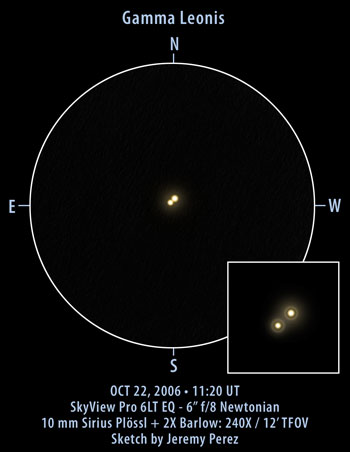
Observation Notes:
This was a stunning, pair of close orange-yellow stars. Their color reminded me of our own sun’s hue during a clear, warm sunset. PA appeared to be about 130 degrees, which compares with the 1990 value of 123 degrees from the WDS Catalog. The stars were separated by about three first-diffraction-ring widths, center to center, which works out to around 3.7 arcseconds. The 1990 WDS value is 4.6 arcseconds.
| Subject | Gamma Leonis (Algieba / STF 1424) |
| Classification | Double Star |
| Position (J2000) | [RA: 10:19:58.5 / Dec: +19:59:28]* |
| Position Angle* | 102° (1828) 123° (1990) |
| Separation* | 2.5″ (1828) 4.6″ (1990) |
| Magnitudes* | A = 2.6; B = 3.8 |
| Spectral Types* | A = K0; B = K0 |
| Date/Time | OCT 22, 2006 – 04:20 AM MST (OCT 22, 2006 – 11:20 UT) |
| Observing Loc. | Cinder Hills Overlook, Sunset Crater National Monument, AZ |
| Instrument | Orion SVP 6LT Reflector (150 mm dia./1200 mm F/L) |
| Eyepieces/Mag. | 10 mm + 2X Barlow (240X) |
| Conditions | Clear, calm |
| Seeing | 5/10 |
| Transparency | NELM Mag 6.8+ |
| References | The Washington Visual Double Star Catalog, 1996.0 (Worley+, 1996), Visual Double Stars in Hipparcos (Dommanget+, 2000) via VizieR |
*Based on published data.
Great diagram and comments! I was just observing Algieba through my new William Optics 88mm refractor and wondered what the separation and PA were. Your drawing and notes were exactly what I was looking for. Really helpful!